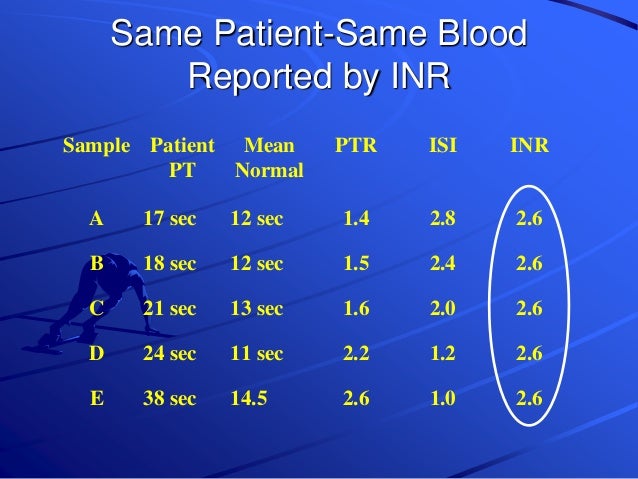

ICD-10 codes not covered for indications listed in the CPB (not all-inclusive):

Phlebitis and thrombophlebitis of upper and lower extremities and unspecified siteĮmbolism and thrombosis of deep veins of lower extremityĪcute embolism and thrombosis of deep veins of upper extremityĬhronic embolism and thrombosis of deep veins of upper extremity Thrombophilia (Antithrombin III deficiency, Factor V leiden, Protein C deficiency, Protein S deficiency) ICD-10 codes covered if selection criteria are met:
#P T INR NORMAL RANGE VERIFICATION#
Physician review, interpretation and patient management of home INR testing for a patient with either mechanical heart valve(s), chronic atrial fibrillation, or venous thromboembolism who meets Medicare coverage criteria includes face-to-face verification by the physician that the patient uses the device in the context of the management of the anticoagulation therapy following initiation of the home INR monitoring not occurring more frequently than once a week Provision of test materials and equipment for home INR monitoring of patient with either mechanical heart valve(s), chronic atrial fibrillation, or venous thromboembolism who meets Medicare coverage criteria includes provision of materials for use in the home and reporting of test results to physician not occurring more frequently than once a week HCPCS codes covered if selection criteria are met:ĭemonstration, prior to initial use, of home INR monitoring for patient with either mechanical heart valve(s), chronic atrial fibrillation, or venous thromboembolism who meets Medicare coverage criteria, under the direction of a physician includes: face-to-face demonstration of use and care of the INR monitor, obtaining at least one blood sample, provision of instructions for reporting home INR test results, and documentation of patient ability to perform testing prior to its use Patient/caregiver training for initiation of home international normalized ratio (INR) monitoring under the direction of a physician or other qualified health care professional, face-to-face, including use and care of the INR monitor, obtaining blood sample, instructions for reporting home INR test results, and documentation of patient's/caregiver's ability to perform testing and report resultsĪnticoagulant management for a patient taking warfarin, must include review and interpretation of a new home, office, or lab international normalized ratio (INR) test result, patient instructions, dosage adjustment (as needed), and scheduling of additional test(s), when performed Codes requiring a 7th character are represented by "+":ĬPT codes covered if selection criteria are met: Information in the below has been added for clarification purposes.
#P T INR NORMAL RANGE CODE#
Table: CPT Codes / HCPCS Codes / ICD-10 Codes Code Self-testing with the device should not occur more frequently than once a week.Īetna considers additional hardware/software systems needed for down-loading data from prothrombin time home testing units to computers for the management of anticoagulation as not medically necessary convenience items.Īetna considers prothrombin time home testing units experimental and investigational for all other indications (e.g., arterial embolism to the eye, atrial flutter, and Kawasaki disease) because its effectiveness for indications other than the ones listed above has not been established.The person must have been anticoagulated for at least 3 months prior to use of the home INR devices and.The expected need for home INR testing is 6 or more months and.
#P T INR NORMAL RANGE PLUS#
This Clinical Policy Bulletin addresses prothrombin time (INR) home testing devices.Īetna considers prothrombin time home testing units/home INR testing (e.g., the Coag-Sense Self-Test PT/INR Monitoring System, the CoaguChek XS Plus System, and the INRatio® 2 PT/INR Monitoring System) medically necessary durable medical equipment for persons who require chronic oral anticoagulation with warfarin for a mechanical heart valve, ventricular assist device, chronic atrial fibrillation, deep venous thrombosis, pulmonary embolism, venous embolism and thrombosis of deep vessels of lower extremity, or hypercoagulable states (e.g., antithrombin III deficiency, Factor V Leiden, protein C deficiency, and protein S deficiency, etc) when all of the following criteria are met: Number: 0173 Table Of Contents Policy Applicable CPT / HCPCS / ICD-10 Codes Background References


 0 kommentar(er)
0 kommentar(er)
